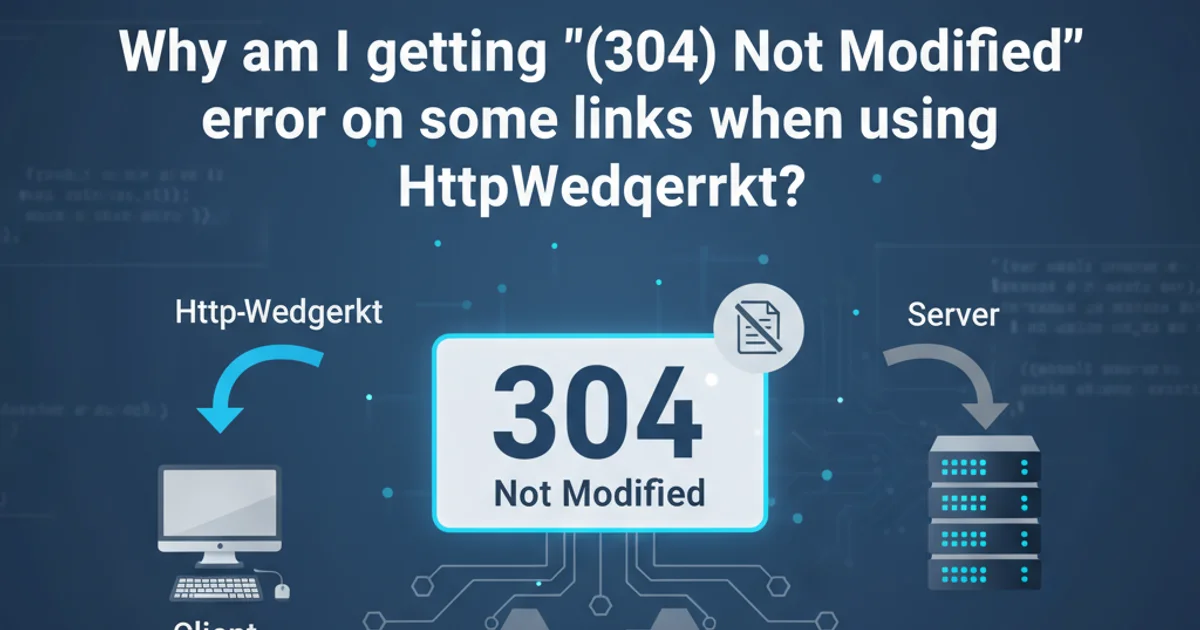Why am I getting "(304) Not Modified" error on some links when using HttpWebRequest?
Categories:
Understanding and Resolving HTTP 304 Not Modified with HttpWebRequest

Explore why HttpWebRequest returns a 304 Not Modified status, how it relates to caching, and strategies to manage or prevent it for optimal application behavior.
When working with HttpWebRequest in .NET, encountering an (304) Not Modified status can sometimes be confusing. This status code isn't an error in the traditional sense; rather, it's an instruction from the server indicating that the resource requested by the client has not changed since the last time it was accessed. This behavior is a fundamental part of HTTP caching mechanisms designed to save bandwidth and improve performance. Understanding when and why this occurs is crucial for building efficient and robust web applications.
The Role of HTTP Caching and 304 Not Modified
The 304 Not Modified status code is a direct result of conditional HTTP requests. When a client (like your HttpWebRequest instance) requests a resource, it can include headers that allow the server to determine if the client's cached version of the resource is still valid. The most common headers used for this are If-Modified-Since and If-None-Match.
If-Modified-Since: The client sends the date and time it last received the resource. If the resource on the server hasn't been modified since that date, the server responds with304 Not Modified.If-None-Match: The client sends an ETag (Entity Tag), which is a unique identifier for a specific version of a resource. If the ETag matches the current ETag on the server, the server responds with304 Not Modified.
When a 304 is received, the client should use its locally cached copy of the resource, as it's still up-to-date. This avoids re-downloading the entire resource, saving bandwidth and reducing latency.
sequenceDiagram
participant Client
participant Server
Client->>Server: GET /resource HTTP/1.1\nIf-Modified-Since: [Last-Modified Date]
alt Resource Not Modified
Server-->>Client: HTTP/1.1 304 Not Modified
Client->>Client: Use Cached Resource
else Resource Modified
Server-->>Client: HTTP/1.1 200 OK\n[New Resource Data]
Client->>Client: Update Cache and Use New Resource
endSequence diagram illustrating the HTTP conditional request flow with If-Modified-Since.
Why HttpWebRequest Might Send Conditional Headers
By default, HttpWebRequest in .NET (especially older versions or when interacting with certain caching configurations) can automatically manage some caching behaviors. If a previous request for the same URL resulted in a 200 OK response with Last-Modified or ETag headers, HttpWebRequest might store this information. On subsequent requests to the same URL, it can then automatically include If-Modified-Since or If-None-Match headers to perform a conditional GET.
This automatic behavior is often desirable for performance, but it can be unexpected if you're not explicitly managing caching or if you always expect a 200 OK response with full content. If you're seeing 304 Not Modified for links you expect to always return content, it's likely due to this implicit caching mechanism or explicit caching headers set by a previous request or the server itself.
using System;
using System.Net;
using System.IO;
public class HttpWebRequestExample
{
public static void Main(string[] args)
{
string url = "http://example.com/some_resource"; // Replace with your target URL
HttpWebRequest request = (HttpWebRequest)WebRequest.Create(url);
request.Method = "GET";
request.AllowAutoRedirect = true;
request.KeepAlive = true;
// Example: Manually setting If-Modified-Since (usually handled automatically)
// request.IfModifiedSince = DateTime.UtcNow.AddDays(-1);
try
{
using (HttpWebResponse response = (HttpWebResponse)request.GetResponse())
{
Console.WriteLine($"Status Code: {(int)response.StatusCode} {response.StatusCode}");
if (response.StatusCode == HttpStatusCode.NotModified)
{
Console.WriteLine("Resource not modified. Using cached version.");
// In a real application, you would retrieve the cached content here.
}
else if (response.StatusCode == HttpStatusCode.OK)
{
Console.WriteLine("Resource modified or new. Reading content.");
using (Stream stream = response.GetResponseStream())
using (StreamReader reader = new StreamReader(stream))
{
string content = reader.ReadToEnd();
Console.WriteLine("Content received (first 100 chars):\n" + content.Substring(0, Math.Min(content.Length, 100)));
}
}
else
{
Console.WriteLine($"Unexpected status: {response.StatusCode}");
}
}
}
catch (WebException ex)
{
if (ex.Response is HttpWebResponse errorResponse)
{
Console.WriteLine($"Error Status Code: {(int)errorResponse.StatusCode} {errorResponse.StatusCode}");
if (errorResponse.StatusCode == HttpStatusCode.NotModified)
{
Console.WriteLine("Caught 304 Not Modified as an exception (less common, but possible depending on context).");
}
}
else
{
Console.WriteLine($"WebException: {ex.Message}");
}
}
catch (Exception ex)
{
Console.WriteLine($"General Exception: {ex.Message}");
}
}
}
C# HttpWebRequest example demonstrating how to handle a 304 Not Modified response.
Strategies to Manage or Prevent 304 Responses
Depending on your application's requirements, you might want to manage or even prevent 304 Not Modified responses. Here are a few approaches:
Embrace Caching (Recommended): If your application can benefit from caching, handle the
304response gracefully. When you receive a304, use the previously stored content for that URL. This is the most efficient approach for static or infrequently updated resources.Disable Automatic Caching (Use with Caution): If you absolutely need to ensure you always get the full content, you can try to disable caching mechanisms. This might involve setting
request.CachePolicytoNoCacheNoStoreor similar, or explicitly removingIf-Modified-SinceandIf-None-Matchheaders if they are being added automatically.request.CachePolicy = new System.Net.Cache.HttpRequestCachePolicy(System.Net.Cache.HttpRequestCacheLevel.NoCacheNoStore); // Or, if you need to clear specific headers: // request.Headers.Remove(HttpRequestHeader.IfModifiedSince); // request.Headers.Remove(HttpRequestHeader.IfNoneMatch);Be aware that aggressively disabling caching can lead to increased network traffic and slower performance.
Force a Fresh Request: Sometimes, simply adding a unique query parameter (like a timestamp or a random GUID) to the URL can bypass caching mechanisms, as the server will treat it as a new, distinct resource request. This is often used for development or debugging.
string url = "http://example.com/some_resource?nocache=" + Guid.NewGuid().ToString(); HttpWebRequest request = (HttpWebRequest)WebRequest.Create(url);Check Server Configuration: The server itself dictates caching headers (
Last-Modified,ETag,Cache-Control). If you control the server, you can adjust these headers to better suit your client's needs. For example, settingCache-Control: no-cacheorCache-Control: no-storewill instruct clients not to cache the resource or to revalidate it every time.